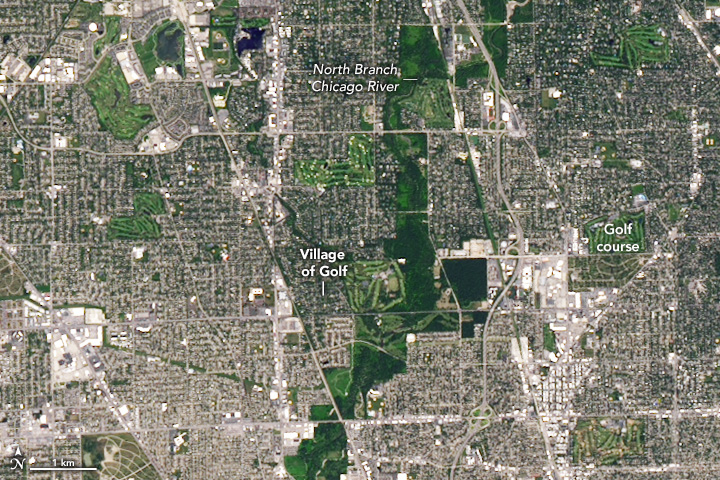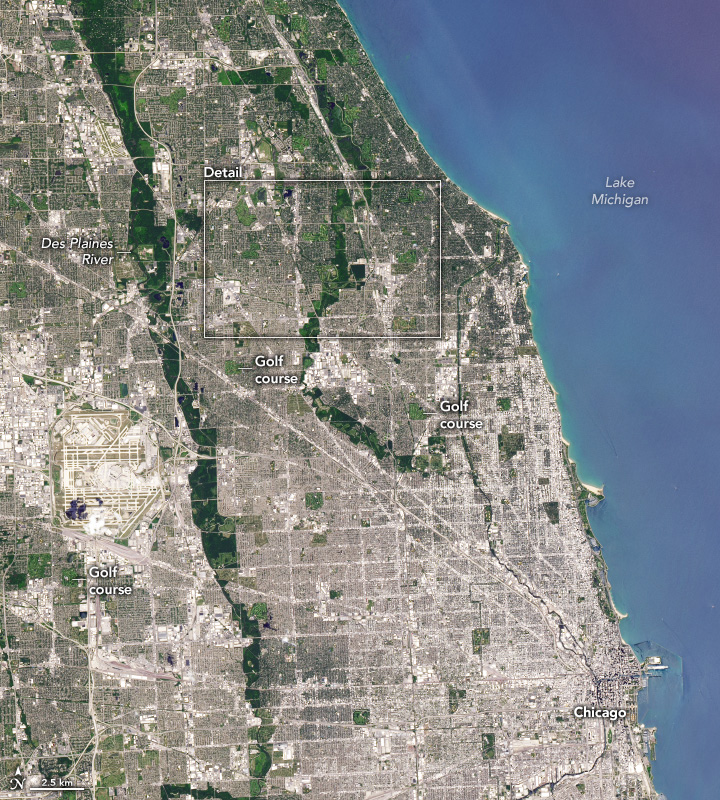
Golfing in Illinois
Downloads
- golf_oli_20240614_lrg.jpg (1188x792, JPEG)
- golfwide_oli_20240614_lrg.jpg (2215x2461, JPEG)
Metadata
- Sensor(s):
- Landsat 8 - OLI
- Data Date: June 14, 2024
- Visualization Date: August 21, 2024
Today’s story is the answer to the August 2024 puzzler.
The suburbs north and west of Chicago contain golf courses—lots of them. At least ten courses dot the landscape in the Landsat 8 image above, captured by the OLI (Operational Land Imager) on June 14, 2024. The image below shows a broader view of the same image, with dozens of courses visible.
The short grasses in the fairways appear as the caterpillar-shaped light-green features flanked by the darker greens of the rough—often tall fescue or other grass varieties that are allowed to grow to a greater height. In satellite imagery, many courses are speckled with bright and dark patches, the water and sand hazards that golfers avoid.
Despite the large number of golf courses in this part of Cook County and in the region more broadly, other U.S. metro areas have an even higher density of courses per capita. The Naples-Immokalee-Marco Island area in southwestern Florida ranks especially high, according to one analysis of U.S. Bureau of Labor Statistics data. Florida is also the state with the most golf courses in total (1,262), according to the National Golf Foundation. That’s 31 percent more than California, the state with the second-most courses. Outside the U.S., only three countries have more than the state of Florida: Japan, the United Kingdom, and Canada.
But there’s one other way this part of Illinois stands out that golfers will appreciate. It’s home to the village of Golf, a small community of 160 households west of Glen View Club, one of the oldest 18-hole courses in the United States. The local train station—and later the village—were named Golf, in part because Albert Earling, a member of Glen View Club and the president of the Chicago, Milwaukee, and St. Paul Railroad company, had the company establish a special train station where he could unhitch his private train car from trains going north before hitting the greens, according to Golf Magazine.
Though numbers have declined in recent decades, the U.S. still had around 16,000 golf courses as of 2024, or about 42 percent of the world’s total. The game requires a large amount of space compared to other sports—about five times more per player than doubles tennis and 37 times more per player than basketball.
All those golf courses cover about 2 million acres, or less than 0.1 percent of the U.S. land surface area. That’s still an area larger than the state of Delaware and more than all the land used to raise Christmas trees, according to an analysis of U.S. land use conducted by Bloomberg. For comparison, the amount of land devoted to feeding livestock, the largest use of land in the U.S., spanned 781 million acres, or 41 percent of the contiguous U.S., the analysis concluded. The analysis was based, in part, on the National Land Cover Database, which is built on satellite observations from the Landsat program, a series of Earth-observing missions jointly managed by NASA and the U.S. Geological Survey.
NASA and the sport of golf have intersected in intriguing ways over the decades. NASA’s honing of an innovative type of threading technology in the 1980s to make screws on the International Space Station extra resistant to vibration eventually led to a sporting goods company achieving the lowest-ever center of gravity in a golf club, NASA Spinoff reported.
A famous connection to the game came in 1971, when astronaut Alan Shepherd attached a 6-iron head to a tool designed to pick up lunar rock samples and hit two golf balls from the surface of the Moon. Shepherd shanked the first shot into a nearby crater but hit the second ball more solidly, propelling it “miles and miles and miles,” the astronaut joked at the time. Three decades later, image restoration by science writer Andy Saunders worked out the exact distances that each of Shepherd’s “moon shots” flew: 24 yards (22 meters) for ball number 1 and 40 yards (37 meters) for ball number 2, Saunders reported in a story for the United States Golf Association.
How far could a golfer theoretically hit a golf ball on the Moon if they were unencumbered by a space suit, like Shepherd was? “If 2016 PGA champion and space enthusiast Jimmy Walker replicated his Earthbound ball speed of 185 miles per hour on the Moon, and used a club that would ensure a 45 degree launch angle, it would travel 2.62 miles (4,611 yards) and stay in the air for more than one minute,” Saunders wrote. “Literally, ‘miles and miles and miles…’.”
References
- Bloomberg (2018, July 31) How America Uses Its Land. Accessed August 20, 2024.
- Choose Chicago (2024) Chicago Golf Courses. Accessed August 20, 2024.
- Golf Course Superintendents Association of America (2017) Land Use Characteristics and Environmental Stewardship Programs on U.S. Golf Courses. Accessed August 20, 2024.
- Golf Magazine (2022, November 21) There’s a town called ‘Golf’. We tracked down its fascinating history. Accessed August 20, 2024.
- Golfweek (2018, July 31) 2 million acres devoted to golf courses across the U.S., report says. Accessed August 20, 2024.
- MyGolfSpy (2024, May 17) The Top 10 Golf States in America. Accessed August 20, 2024.
- NASA (2013, May 19) Alan Shepard Hits A Golf Ball on the Moon. Accessed August 20, 2024.
- NASA (2017, October 4) Better Golf Game with NASA Tech. Accessed August 20, 2024.
- NASA (2022) Did you know the Artemis I Space Launch System can caddy 27 tons of cargo to the Moon? Accessed August 20, 2024.
- NASA Spinoff (2017) Novel Threading Enables New Approach to Golf Clubs. Accessed August 20, 2024.
- National Golf Foundation (2024, February 29) Golf Supply Update: More Openings, Fewer Closings. Accessed August 21, 2024.
- National Golf Foundation (2024, March 14) How Does Golf in Your State Stack Up? Accessed August 20, 2024.
- National Golf Foundation (2024, February 29) New Golf Facilities in the U.S. Report Now Available. Accessed August 20, 2024.
- PGA of America (2022, February 1) Out of this World: The Work Done by NASA Has Helped Change Golf. Accessed August 20, 2024.
- Shaddox, T. et al., (2023) Land-use and Energy Practices on US Golf Courses. HortTechnology, 33(3), 296-304.
- United States Golf Association (2024) The Mystery Behind Alan Shepard’s ‘Moon Shot’ Revealed. Accessed August 20, 2024.
- United States Golf Association (2024, April 5) The Environmental Benefits of Golf Courses. Accessed August 21, 2024.
- World Population Review (2024) Golf Courses by State 2024. Accessed August 20, 2024.
NASA Earth Observatory images by Wanmei Liang, using Landsat data from the U.S. Geological Survey. Story by Adam Voiland.
This image record originally appeared on the Earth Observatory. Click here to view the full, original record.
